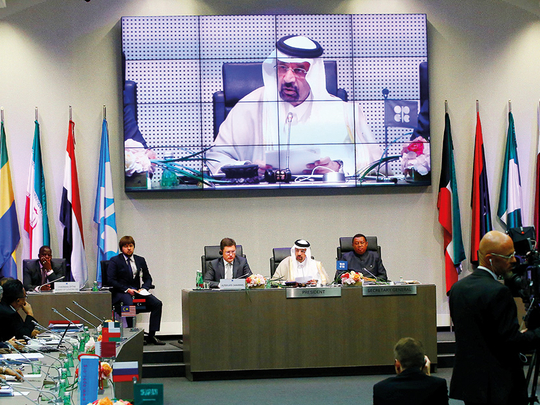
Abu Dhabi: Opec decided to extend output cuts for another nine months as global oversupply continues to dog oil markets.
At a meeting in Vienna on Thursday, Opec and non-Opec members led by Russia decided to prolong production cuts till March 2018 to support oil prices.
Khalid Al Falih, Saudi Arabia’s energy minister said they considered various scenarios of extension of six months to nine months to 12 months and also looked into higher cuts.
“All indications are solid for a nine-month extension, which should bring oil inventories to five years’ average by the end of this year. We will be at target before the year-end,” he said during a press conference, telecast live on Opec website.
Oil prices fell on Thursday despite the extension of the agreement. Brent crude was trading at $52.34 per barrel, down by 3 per cent at around 8pm on Thursday. West Texas Intermediate was down by 3.19 per cent at $49.72 per barrel.
Edward Bell, commodity analyst at Emirates NBD, said the size of the cuts won’t be enough to rebalance oil markets. “In the short term, you may get a turnaround or at least prevent prices falling from where they are currently. In the longer term, it would be a challenge due to increase in production from the US and other non-participating countries like Brazil or Canada. If they had deepened cuts, the process of rebalancing and drawing down of excess inventories would have helped but that would have come at the cost of giving up the market share.”
Spencer Welch, Director of IHS Energy in London said the cut extension is already priced into the market. “The market wanted increased level of cuts. The market is worried about rising US production, high global inventories and release of US strategic stocks. Even with six to nine month cut extension we expect oil price to remain in $50 to $55 per barrel range through 2017 and 2018.”
Compliance to the deal is expected to be good if the oil price does not rally much but if the oil price touches $60 per barrel, then there is a possibility of participating countries cheating to increase production, Bell added.
In his opening address to the Opec meeting on Thursday, Al Falih said that the market is on its way to rebalancing but more needs to be done in lowering oil inventories toward five year average. He said stakeholders across the spectrum are benefiting from the improved situation — not only the producers who are part of the supply agreement but other countries as well.
IOCs (international oil companies) are also posting their best quarterly earnings in two years, Al Falih said adding investment flows into the upstream sector have picked up, albeit at a slower pace than required to meet forecast long-term demand.
“And despite potential volatility, I expect the situation to continue improving, assisted by a more robust global economy and higher GDP growth in 2017, as well as fairly healthy oil demand growth this year, particularly in Asia,” he said in the speech which is posted on Opec’s website.
Mihir Kapadia, CEO of London based Sun Global Investments, said the focus will now shift to how US crude and how shale producers respond to higher prices.
“This sector has been one of the biggest headaches for Opec as they have been flexible in increasing output in response to higher prices,” he said through email.
“Today’s news may boost oil prices in the short term, however it is unlikely to go above $55 (per barrel) in the medium term as flexible shale producers have become the main determinant of the marginal prices of oil.”.
Thirteen members of the Opec and 11 non-Opec members agreed to cut production by about 1.8 million barrels a day to prop up oil prices in December last year.
Opec agreed to slash output by 1.2 million barrels a day and non-Opec members and Russia by 558,000 barrels a day. The agreement came into effect from January 1 with oil prices moving upward and touching $56 per barrel in the subsequent months after a prolonged period of low oil prices in the previous year.
Equatorial Guinea became the latest member of Opec on Thursday taking the total number of members to fourteen.












